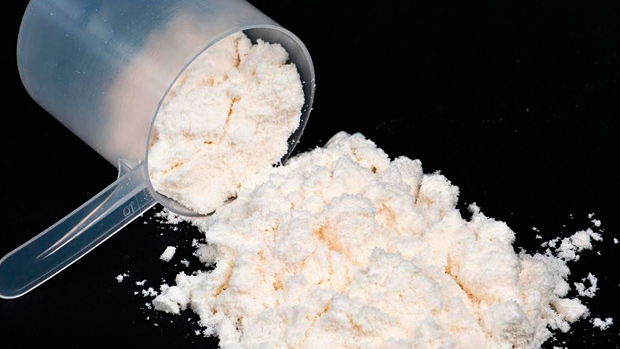In the highly competitive world of athletics, the margin separating victory from defeat is often small. As a result, athletes know that the difference between medaling and placing off the podium can be a few hundredths of a second.
They know the difference between optimal performance and sub-optimal performance means optimizing all aspects of their sport. They also know that all else being equal, any little edge they can get over their competition will likely lead to more successful performances.
As a result, ergogenic aids have emerged as a vital component in the training regimens of athletes. An ergogenic aid is generally a substance or training device known to enhance athletic performance.
Of course, with over 30,000 nutritional supplements and natural food products competing in the marketplace today, many of which promise better body composition and performance, few promises of improved performance are realized. (Yep, you read that right – 30,000). It's no surprise that it's often difficult for athletes to sort out what works from what doesn't.
In this article, we'll discuss the effectiveness of one of these supposed ergogenic aids – branched chain amino acids (BCAA). While BCAA aren't new, there's a wave of new research looking at how this unique group of amino acids can impact body composition and performance. As a result of this literature, it's clear that BCAA may improve performance and body composition in certain situations.
This article will focus on three potential mechanisms of action by which BCAA can impact performance:
- Enhanced muscle protein synthesis and muscle protein accretion in response to strength training and BCAA supplementation.
- Improved body weight control and fat loss during energy restricted diets with adequate protein and BCAA.
- Improved endurance performance via the prevention of central fatigue and/or other factors with BCAA supplementation.
About BCAA
The branched chain amino acids consist of three essential amino acids:
- Leucine
- Isoleucine
- Valine
These hydrophobic (water-fearing) amino acids are referred to as "aliphatic" as their central carbon attaches to a branched non-cyclic, open carbon chain, as seen below with leucine.

It's been shown that BCAA can comprise up to one-third of muscle protein (Mero, 1999) and of the three BCAA, leucine is the most heavily researched. It's this amino acid that appears to offer the biggest physiological benefit.

Based on what we currently know, leucine has a higher oxidation rate in skeletal muscle due to its chemical structure, plays a significant role in protein synthesis, and is unique in its ability to participate in several metabolic processes. Specifically, researchers believe that the BCAA, especially leucine, may work through the following mechanisms:
- Modulation of insulin signaling
- Regulation of muscle protein translation initiation
- Nitrogen donation for alanine and glutamine
- Prevention of free tryptophan in plasma from entering the brain and central nervous system
Leucine and Resistance Training
It's common knowledge among the scientific community that resistance training results in the hypertrophy of trained muscles, largely due to increased protein synthesis in relation to protein breakdown. Of course, studies have shown protein degradation also increases with strength training, and only with proper nutritional intake is a net gain in protein status – leading to increased muscle mass – observed (Blomstrand et al, 2006).
This alone highlights the vital role nutrition can play in muscle growth, as both carbohydrate and protein intake can be beneficial. Simply put, adequate protein intake and overall caloric intake are required to stimulate a positive protein balance in response to resistance training.
How these shifts in protein intake come about is a hotly debated topic. Some researchers believe that an increased availability of amino acids at the muscle directly stimulates protein synthesis. Others believe that muscle protein synthesis increases via a stimulatory effect of a single amino acid or group of amino acids such as the BCAAs (Blomstrand et al, 2006).
Others believe that certain amino acids (such as the BCAA) are capable of stimulating a variety of metabolic pathways, including the modulation of insulin release, and it's the anabolic potential of insulin – in the presence of amino acids – that triggers muscle growth. Of course, some researchers believe that all these are necessary to promote training-induced muscle growth.
Leucine and the Modulation of Insulin Release
As many know, the release of insulin has been correlated with many anabolic properties involved with tissue building. Insulin has been proven to stimulate protein synthesis and inhibit protein breakdown when administered both during and post-exercise (Manninen et al, 2006).
Interestingly, in an investigation by Manninen in 2006 involving the supplementation of a carbohydrate, protein hydrolysate, and leucine mixture taken during exercise, it was demonstrated that this mixture leads to greater increases in skeletal muscle hypertrophy and strength vs. a placebo supplement.
It was once believed that insulin secretion was controlled almost entirely by blood glucose concentration. It's since become apparent that amino acids play a crucial role in the regulation of insulin secretion. Certain amino acids have been shown to cause insulin release in humans, even under conditions where blood sugar levels are normal (Manninen et al, 2006).
Of course, in order for most amino acids to effectively stimulate pancreatic beta cell insulin release, permissive levels of blood glucose (2.5 – 5.0 mM) must be present. Interestingly, leucine is an exception, as it's the only amino acid capable of increasing circulating insulin levels regardless of blood glucose concentration (Manninen et al, 2006). The increase of insulin has been shown to decrease the rate of muscle protein degradation.
By limiting protein degradation, leucine may allow for a net protein synthesis post-resistance exercise, leading to greater muscle hypertrophy. Essentially, this insulin response will provide an environment that promotes tissue building, as opposed to tissue breakdown.
Yet here's an important question: if an insulin release produces muscle growth, why wouldn't you simply drink a carbohydrate solution to get this insulin response?
In a study examining plasma insulin release, a 221% greater insulin response was achieved when subjects ingested a high glycemic carbohydrate bolus with protein hydrolysate and leucine as opposed to carbohydrate alone. When the subjects ingested carbohydrate with protein hydrolysate, but without leucine, a 66% greater insulin response was observed than with carbohydrate alone (Manninen et al, 2006).
Based on these results, it's evident that leucine supplementation is beneficial to resistance exercise in terms of its ability to modulate insulin signaling. Post-exercise hyperinsulinaemia (high insulin) supported by hyperaminoacidaemia (high amino acids) induced by protein hydrolysate and leucine ingestion increases net protein deposition in muscle, leading to increased skeletal muscle hypertrophy and strength (Manninen et al, 2006).
So, the bottom line is this: during and post-exercise, it's ideal to ingest a fast-digesting drink of hydrolyzed protein, sugary carbs, and some additional BCAA (especially leucine) because of the combined high blood insulin and high blood amino acid concentrations that accompany such a beverage.
However, based on the research, this type of drink doesn't only work through the modulation of insulin release. Leucine helps grow muscle because it's also a key element in the activation of translational pathways responsible for muscle growth.
Leucine and the Initiation of Translation
Translation, as a review, is the synthesis of protein as directed by mRNA (messenger RNA). It's the first of three stages in protein synthesis, with the other two stages being chain elongation and termination (Norton.et al, 2006). Without translation, there can't be protein synthesis or muscle growth.
Previously, the effects of resistance exercise in relation to protein balance were discussed. It was determined that after exhaustive resistance training, the body is in a catabolic state until nutrition is provided, activating the recovery phase. During this catabolic state, muscle protein synthesis becomes impaired (at the cellular level) due to the inhibition of specific translation initiation factors.
These factors – eIF4G, eIF4E and rpS6 specifically – are what turn on the process of translation and eventually, protein synthesis. And they're controlled by, you guessed it, intracellular insulin signalling and leucine concentrations (Norton.et al, 2006). Therefore, the anabolic effect of exercise and nutrition is likely mediated by activating signal transduction of these initiating factors.
It's been revealed that activation of this translational pathway (displayed below; Layman et al, 2006) is crucial for skeletal muscle recovery and hypertrophy.

As you can see, leucine is necessary for the activation of certain initiation factors. When leucine is ingested, tissue levels increase. This means the inhibition of the above mentioned initiation factors is released. This happens through activation of the protein kinase mammalian target of rapamycin (mTOR above).
Leucine's effect on mTOR is also synergistic with insulin via the phosphoinositol 3-kinase signaling pathway (PI3 above; Norton.et al, 2006). Together, insulin and leucine allow skeletal muscle to coordinate protein synthesis. The figure below provides evidence supporting the above hypothesis.


In the figure above (Blomstrand et al, 2006), BCAA supplementation consumed post-resistance exercise had a significant effect on translation initiating factors p70S6 kinase and mTOR. The role of leucine and other BCAA is to phosphorylate the proteins serine and threonine, which in turn will produce a phosphorylating cascade eventually initiating the translation of protein synthesis.
The fundamental idea to take away is that BCAA, in particularly leucine, reverse the inhibition of translation produced by resistance training. In reversing this inhibition, BCAA will allow for increased muscle hypertrophy through greater levels of protein synthesis.
At this point, you might be wondering why supplemental leucine is necessary when skeletal muscles are already comprised of one-third BCAA. Well, during resistance training, BCAA oxidation in skeletal muscle increases through activation of the branched-chain a-keto acid dehydrogenase (BCKDH).
This means that plasma and intracellular concentrations of leucine decrease. Consequently, the ability of leucine to stimulate insulin release and initiate translation will be diminished until during or post-exercise supplementation is provided.
BCAA, Resistance Training, and Protein Synthesis – What's The Verdict?
So, in the end, the question to ask is this: is leucine supplementation an ergogenic aid in terms of resistance training?
Based on the current literature and the information provided above, the answer is yes. Leucine can act as an ergogenic aid for resistance training athletes based on its ability to modulate insulin signaling and initiate translation of protein synthesis. Both of these factors contribute to greater skeletal muscle hypertrophy and strength.
Leucine and Endurance Exercise
Every athlete and trainer understands that fatigue limits performance. Reduced muscle force output, depletion of muscle glycogen, dehydration, as well as cardiac, metabolic, and thermoregulatory strain are all peripheral factors contributing to fatigue. In turn, athletes train extensively to delay the onset of these mechanisms.
Central fatigue, a form of exhaustion associated with specific alterations to the central nervous system, also plays a crucial role in performance and is the focus for this section of the article. A great deal of research is being done in regards to BCAA and their capability to delay the onset of central fatigue and improve endurance exercise performance.
The Central Fatigue Hypothesis
The idea that branched chain amino acids might inhibit central fatigue isn't new. Many researchers and coaches have hypothesized that BCAA may improve performance by limiting central fatigue.
It's thought that BCAA can compete with plasma free tryptophan (an essential amino acid) for uptake into the brain. Tryptophan is a precursor to serotonin and tryptophan concentrations increase during prolonged exercise.
When performing endurance type exercise, the stress on the body causes significant hormonal alterations (Meeusen et al, 2006). Specifically, increased levels of the hormone adrenaline/epinephrine stimulate lipolysis, the hydrolysis of fats into fatty acids, and glycerol (fat release from stored fat depots).
As these free fatty acids (FFA) are mobilized, plasma levels of f-TRP increase as the increased concentration of plasma FFA can displace f-TRP from its protein carrier, albumin. With all those FFA binding to albumin, f-TRP is readily available for transport across the blood brain barrier where it leads to an increase in serotonin levels (Meeusen et al, 2006).
A high concentration of serotonin in the brain is associated with a decrease in exercise performance, and this is what's known as central fatigue (Crowe et al, 2006). Accordingly, if BCAA compete with f-TRP for uptake into the brain, serotonin levels will remain low, diminishing central fatigue and improving exercise performance.
Great theory, eh? Unfortunately, the studies examining this hypothesis have been mixed. Most animal studies show some positive effects; most human studies show no differences in central fatigue with BCAA supplementation.
Recently, an investigation was performed to determine the effects of BCAA supplementation on outrigger canoeists, with particular emphasis on central fatigue. Leucine was provided as a dietary supplement for six weeks, with the purpose to improve endurance performance by increasing plasma BCAA concentrations and decreasing the plasma ratio of f-TRP to BCAA (Crowe et al, 2006).
The data indicated a performance increase when outrigger canoeists were supplemented with leucine, thus leucine was proven to have an ergogenic effect with these athletes. The data did not, however, illustrate any associations between the increased performance and central fatigue, as there was no significant reduction in the plasma ratio of f-TRP to BCAA (Crowe et al, 2006).
Instead, it was predicted the ergogenic effect was a product of reduced skeletal muscle damage with training in addition to increased skeletal muscle synthesis.
BCAA and Endurance Training – The Verdict
Although it remains a promising theory, based on the current research, BCAA are not an ergogenic aid for endurance exercise in terms of delaying central fatigue onset. However, there may be other potentially advantageous effects when supplementing with BCAA for endurance exercise, as seen in the study above. More research in this area may help clarify just how BCAA can impact endurance exercise.
BCAA and Body Weight Management
Among the many popular methods used for controlling body weight and weight loss, all successful strategies have one thing in common – they control energy balance. If weight loss is what we're after, the goal is to attain a negative energy balance where energy expenditure exceeds energy intake. Popular strategies for doing so involve limiting dietary fat and total calories while ingesting enough protein to maintain nitrogen balance. But let's go one step further with the current recommendations.
The current nutritional practice for weight loss espoused by many dietitians involves minimum levels of dietary protein and fat, with carbohydrates providing the remaining energy requirements. Therefore, based on current dietary guidelines, if one were to consume 2100 kcal/day then approximately 820 kcal/day would be obtained from protein and fat where the remaining 1280 kcal/day would be from carbohydrates (Layman, 2003).
The nutritional example provided above displays a CHO:PRO ratio of greater than 3.5. In a diet with the intention of weight loss, this ratio may be too high. Research has established that high carbohydrate diets are associated with the following:
- Reduced body fat oxidation
- Increased blood triglyceride levels
- Reduced satiety (feeling of fullness)
These effects don't correspond with weight loss goals and raise new questions about the optimal ratios of macronutrients to balance energy needs, especially when it comes to carbohydrate intake.
Previously, the focus for weight loss was on CHO:FAT ratios, but current research is focusing on CHO:PRO (Layman, 2003). The reason for this shift is the emerging evidence that a) higher carbohydrate diets might thwart weight loss attempts and b) some amino acids have additional metabolic roles requiring plasma and intracellular levels above those capable from the current required daily amount (RDA). This brings leucine and its capacity in metabolism to the forefront.
The diversity of proteins suggests a single RDA may no longer be adequate, as different amino acids contribute different roles to body function. Therefore, amino acids should logically be required in amounts pertaining to those roles.
The first priority of leucine is always the synthesis of muscle protein, which has a requirement of 1-4 g/day. It's only after the requirements for protein synthesis are met that leucine can partake in other metabolic roles, which require 7-12g/day (Mero, 1999). This would result in a total leucine requirement of approximately 8-16 g/day proving the current RDA of 3g/day to be insufficient.
Leucine and the Regulation of Blood Glucose
When BCAA are broken down in skeletal muscle (specifically leucine, as it's the most readily oxidized) it leads to the production of alanine and glutamine, which become important in the maintenance of glucose homeostasis (Layman, 2003).

The glucose-alanine cycle (above; Layman et al, 2006) demonstrates the interrelationship between BCAA and glucose metabolism. In the figure above it can be seen that BCAA aren't degraded by the liver as they move through the blood to skeletal muscle intact.
After BCAA oxidation, alanine is formed and released into the blood where it moves into the liver to support hepatic gluconeogenesis – the production of glucose from non carbohydrate sources (Layman, 2003).
Glutamine, another byproduct of BCAA oxidation, is also converted into alanine in the small intestine and travels to the liver as a gluconeogenenic precursor. This continuous alanine → pyruvate → glucose → pyruvate → alanine cycle allows for hepatic glucose production and the maintenance of blood glucose.
So, as observed above, leucine indirectly serves as the primary fuel for hepatic glucose production. The significance of this is that during an overnight fast, as well as during hypocaloric situations such as weight loss, gluconeogenesis provides a large amount of total hepatic glucose release (70% after an overnight fast; Layman, 2003).
Theoretically, this would allow one to ingest a lower carbohydrate diet while being able to maintain normal, healthy blood glucose levels, a usual danger of low carbohydrate diets. In fact, it's been estimated that approximately 100g carbohydrate/day will satisfy the energy needs of obligate carbohydrate users such as the brain, nervous tissue, and blood cells (Layman, 2003).
Therefore, if dietary restriction is warranted, one could theoretically do well by ingesting only 100g carbohydrate/day with gluconeogenesis supplying glucose for the obligate users (brain, nervous tissue, blood cells) as well as managing normal blood glucose levels. Ultimately, this may permit an individual to achieve greater weight loss results by ingesting moderate amounts of dietary fat, reducing total carbohydrate intake, and increasing protein consumption so that a new CHO:PRO ratio of 1.5-2.0 is achieved.
Of course, this may not work for everyone, but this strategy is one that deserves consideration.
Translation Initiation
The second metabolic role of leucine pertinent to weight loss (aside from leucine's involvement in gluconeogenesis) involves the previously mentioned regulation of translational pathways.
As stated above, a hypocaloric period, such as weight loss, necessitates an overall negative energy balance. Consequently, the body's catabolic state during weight loss often results in loss of lean body tissue. As leucine has the ability to reverse the inhibition of translation seen during catabolic conditions, it may help prevent the loss of lean body tissue, allowing one to maintain muscle mass while decreasing fat mass.
BCAA, Blood Sugar, Translation, and Weight Loss – The Research
This theory was investigated in a study published in 2003 (Layman et al, 2003) which examined weight loss and metabolic responses between subjects consuming one of two different CHO:PRO ratios: 3.5 or 1.5 while either exercising five days per week or while performing no exercise.
- All subjects consumed 1700 kcal/day, with a fat intake of 50g/day and an energy deficit of at least 500kcal/day (a weight loss of at least one pound per week).
- The group consuming a CHO:PRO ratio of 3.5 was based on the current dietary guidelines for fat (30%) and energy intake, as well as the RDA for protein (0.8g/kg-d) including 5g of leucine.
- The group consuming a CHO:PRO ratio of 1.5 provided increased protein consumption (1.5g/kg-d) as well as an additional 5g/day of leucine (10g).
- The exercise was constant within each study.
Subjects in study one maintained normal daily activities with no defined exercise, where subjects in study two exercised five days a week with a specific exercise regimen producing an additional expenditure of 300 kcal/day.
The figure below illustrates the benefits associated with the higher protein intake during both exercise and non-exercise conditions.

In the protein group, body weight loss was significantly greater with smaller losses observed in lean body mass and a greater loss in fat mass. This effect was amplified when subjects also exercised.
The Verdict?
So, is leucine supplementation an ergogenic aid in terms of weight loss? According to the research discussed, it's evident that higher protein diets (and higher leucine intake) can benefit athletes who wish to decrease their fat mass while maintaining or possibly increasing lean body mass.
Conclusions
Branched chain amino acids are an emerging supplement and the potential effects of BCAA aren't yet completely understood. The ability of BCAA (especially leucine) to modulate insulin secretion, initiate translational pathways, and indirectly produce alanine and glutamine distinguish it from other amino acid supplements.
Although animal studies have concluded branched chain amino acids can delay the onset of central fatigue by competing with f-TRP to enter the brain, no substantial evidence has been seen in humans. Nevertheless, branch chain amino acid supplementation may prove to help athletes increase muscle mass, decrease fat mass, and improve exercise performance in both strength and endurance sports.
Athletes who are searching for ways to bulk up and lean out should certainly ensure optimal intakes of BCAA from their food and, as it may be difficult to get the recommended 8-16g of leucine/day from protein alone, consider using BCAA supplements if the diet is lacking. Further, additional targeted BCAA supplementation (during and/or post-exercise) may offer additional benefits in terms of increasing lean body mass.
In short, it's clear that BCAA may improve performance and body composition in certain situations.
Selected References
- Juhn, M. Popular Sports Supplements and Ergogenic Aids. 2003.
- Manninen, A. Hyperinsulinaemia, hyperaminoacidaemia and post-exercise muscle anabolism: the search for the optimal recovery drink. 2006.
- Mero, A. Leucine Supplementation and Intensive Training. 1999.
- Schwenk, T. When Food Becomes A Drug: Nonanabolic Nutritional Supplement Use in Athletes. 2003.
- Bassit, R. Branched-chain amino acid supplementation and the immune response of long-distance athletes. 2002.
- Blomstrand, E. Branched-chain amino acids activate key enzymes in protein synthesis after physical exercise. 2006.
- Crowe, M. Effects of dietary leucine supplementation on exercise performance. 2006.
- Layman, D. The Role of Leucine in Weight Loss Diets and Glucose Homeostasis. 2003.
- Norton, L. Leucine regulates translation initiation of protein synthesis in skeletal muscle after exercise. 2006.
- Meeusen, R. Central FatigueThe Serotonin Hypothesis and Beyond. 2006.
- Shimomura, Y. Exercise promotes BCAA catabolism: effects of BCAA supplementation on skeletal muscle during exercise. 2004.





